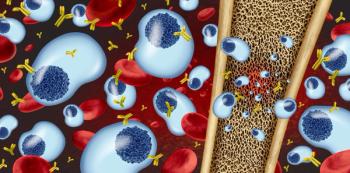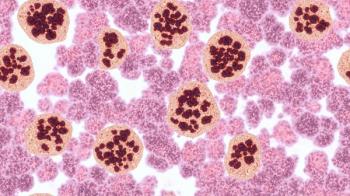
NLA 2025: The Earlier LDL Cholesterol Is Lowered, the Greater the Cardiovascular Risk Reduction
Kausik K. Ray, MD, discussed the importance of early, aggressive, and sustained LDL-C lowering for atherosclerotic cardiovascular disease prevention, highlighting that the magnitude of cardiovascular risk reduction is independent of the specific lipid-lowering therapy used.
As the evidence base for lipid management continues to grow, understanding the timing, intensity, and duration of therapy has become crucial for optimizing patient outcomes. At the 2025 National Lipid Association (NLA) Scientific Sessions, Kausik K. Ray, MD, FMedSci, discussed the importance of early, sustained, and aggressive low-density lipoprotein cholesterol (LDL-C) lowering for atherosclerotic cardiovascular disease (ASCVD) prevention. Ray, immediate past president of European Atherosclerosis Society, professor of public health and consultant cardiology at Imperial College London, and director of the Imperial Centre for Cardiovascular Disease Prevention at Imperial College London, underscored that the earlier clinicians initiate LDL-C lowering therapies—and the longer patients adhere to these therapies—the greater the reduction in major adverse cardiovascular events (MACE), independent of the specific lipid-lowering agent used.1
Ray explained that the conventional focus on high cholesterol as a diagnostic label belies the underlying pathophysiology of atherosclerosis driven by cholesterol retention in the arterial wall. Approximately 90% of circulating apolipoprotein B (apoB)-containing particles are LDL, making LDL-C the primary target for ASCVD prevention. While other lipoproteins, such as lipoprotein(a) and remnant particles, contribute to residual risk, LDL-C remains the cornerstone of atherogenic burden. Importantly, even modestly elevated LDL-C levels can accelerate plaque formation, especially in individuals with diabetes, hypertension, or smoking-related arterial injury.1
Various LDL-C lowering strategies, including dietary interventions, statins, ezetimibe (Zetia; Merck and Schering-Plough Pharmaceuticals), bempedoic acid (Nexletol; Esperion), proprotein convertase subtilisin/kexin type 9 (PCSK9) inhibitors, and small interfering RNA (siRNA) agents, ultimately enhance LDL receptor activity to increase LDL clearance. Agents such as statins and bempedoic acid reduce hepatic cholesterol synthesis, leading to upregulated LDL receptor expression, whereas ezetimibe and dietary modification reduce intestinal cholesterol absorption, achieving similar effects. PCSK9 inhibitors, such as alirocumab (Praluent; Sanofi/Regeneron) and evolocumab (Repatha; Amgen), and siRNA therapies, such as inclisiran (Leqvio; Novartis), act by prolonging LDL receptor lifespan, allowing for sustained LDL-C clearance.1
Ray also highlighted the consistency of benefits across lipid-lowering therapies. Analyses of randomized controlled trials and meta-analyses, such as ODYSSEY Outcomes (NCT01663402) and FOURIER (NCT01764633), have demonstrated that each 1 mmol/L (~38.7 mg/dL) reduction in LDL-C corresponds to a relative risk reduction in MACE.1-3 ODYSSEY Outcomes assessed alirocumab plus statins in patients with recent acute coronary syndrome, showing significant LDL-C lowering and a 15% relative risk reduction in MACE. FOURIER evaluated evolocumab added to statin therapy in patients with high-risk ASCVD, demonstrating a 59% LDL-C reduction and a 15% relative risk reduction in the primary composite end point over a median of 2.2 years.1 Furthermore, Ray noted that these benefits are agnostic to the pharmacologic pathway—whether achieved by statins, ezetimibe, PCSK9 inhibitors, or bempedoic acid. This was further supported by findings from the CLEAR Outcomes trial (NCT02993406), which evaluated bempedoic acid in statin-intolerant patients. Data showed that LDL-C reductions achieved through ATP-citrate lyase inhibition resulted in risk reductions consistent with those seen in prior statin and PCSK9 inhibitor studies.1,4
Ray presented compelling data from simulation models and registry studies that emphasize the critical importance of treatment timing. For instance, analyses from the SWEDEHEART registry indicate that initiating high-intensity statins and combination therapy (eg, adding ezetimibe) within 12 weeks of an acute myocardial infarction significantly reduces MACE compared to delayed intensification. The SWEDEHEART Registry Analysis simulated the impact of early vs delayed combination therapy, showing substantial reductions in cardiovascular mortality and nonfatal myocardial infarction/stroke with earlier intervention. According to Ray, delaying LDL-C target achievement, even by a few months, can result in persistent excess risk that is never fully mitigated, even with later intensification of therapy.
“About a month ago, we published this data from SWEDEHEART essentially trying to simulate a trial where you give statins and ezetimibe early after myocardial infarction within 12 weeks, or you give them the medication on combination therapy between 12 weeks, 16 months, or never,” Ray said during the NLA presentation. “You can never ethically do a trial where you delay an intervention that you've already got data for. So, this is the closest we're ever going to get to trial evidence, if you will.”
Ray explained that findings from this analysis have significant public health implications for optimizing LDL-C management. The modeling data suggest that universal early combination therapy could prevent thousands of MACE events annually. These findings reinforce the need for system-level changes in care pathways and interventions focused on implementing guideline-directed therapy effectively, according to Ray.
“If you change your care pathway, and instead of a stepwise approach, you just [adopt a] standard of care [in which you] give people a high intensity statin and ezetimibe, for a population of 35,000, there will be 477 fewer events,” Ray said. “But for a country like the US, where there's probably a quarter of a million myocardial infarctions per year, the number of events you're going to get over 3 years is 17,934 events, meaning in 3 years, that policy change alone is going to prevent about 3000 MACE events.”
REFERENCES
Ray KK. LDL-C early sustained and comprehensive control. NLA Scientific Sessions; Miami, Florida; May 29-June 1.
ODYSSEY Outcomes: Evaluation of Cardiovascular Outcomes After an Acute Coronary Syndrome During Treatment With Alirocumab. Clinicaltrials.gov. Updated March 18, 2019. Accessed May 31, 2025.
https://clinicaltrials.gov/study/NCT01663402?term=NCT01663402&rank=1 Further Cardiovascular Outcomes Research With PCSK9 Inhibition in Subjects With Elevated Risk (FOURIER). Clinicaltrials.gov. Updated May 28, 2024. Accessed May 31, 2025.
https://clinicaltrials.gov/study/NCT01764633?term=NCT01764633&rank=1 Evaluation of Major Cardiovascular Events in Participants With, or at High Risk for, Cardiovascular Disease Who Are Statin Intolerant Treated With Bempedoic Acid (ETC-1002) or Placebo (CLEAR Outcomes). Clinicaltrials.gov. Updated January 1, 2024. Accessed May 31, 2025.
https://clinicaltrials.gov/study/NCT02993406?term=NCT02993406&rank=1
Newsletter
Stay informed on drug updates, treatment guidelines, and pharmacy practice trends—subscribe to Pharmacy Times for weekly clinical insights.




















































































































































































































